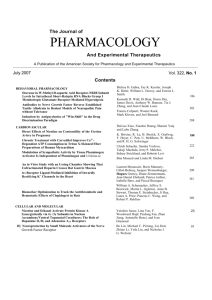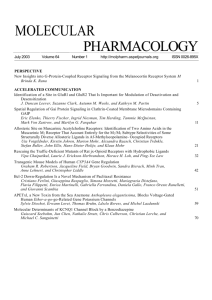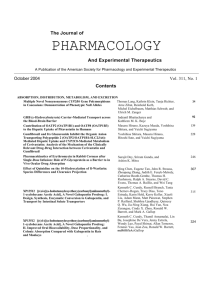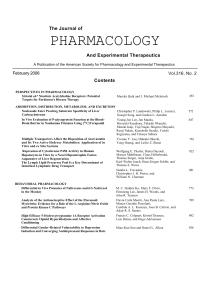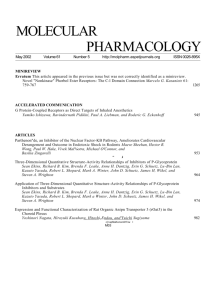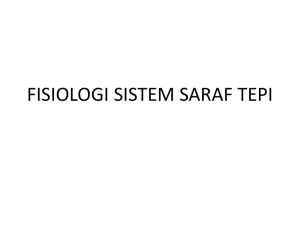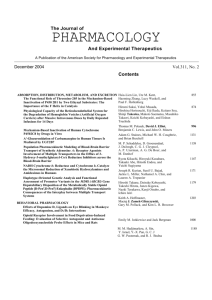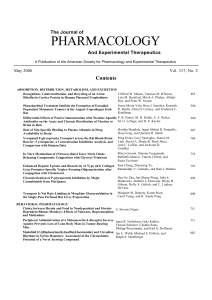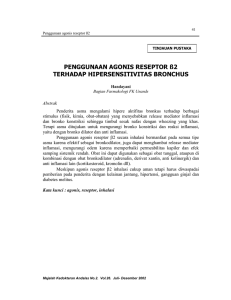receptors - WordPress.com
advertisement
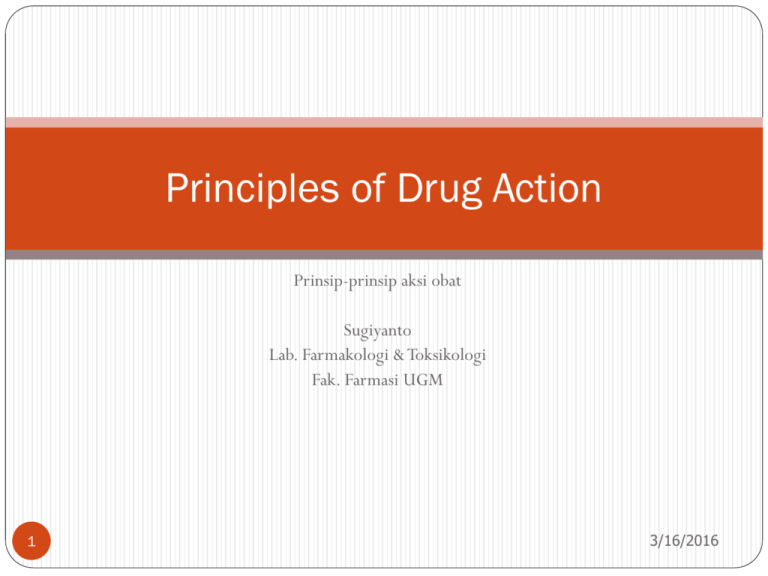
Principles of Drug Action Prinsip-prinsip aksi obat Sugiyanto Lab. Farmakologi & Toksikologi Fak. Farmasi UGM 1 3/16/2016 General Overview A few drugs act by virtue of their physicochemical properties, e.g. laxative agent (MgSO4), general anesthetics (based on its lipid solubility (?), osmotic diuretics (mannitol) Some drugs act as false substrates (sulphonamides) or inhibitor for certain transport systems (cardiac glycosides) or enzymes (NSAIDs) Most drugs produce their effects by acting on specific protein molecules, usually located in the cell membrane. These proteins are called receptors 2 3/16/2016 Prinsip aksi obat 3 3/16/2016 Receptor, Agonist & Antagonist Receptors normally respond to endogenous chemicals in the body. These chemicals are either synaptic transmitter substances (neurotransmitters) or hormones, for example acetylcholine, epinephrine, insulin, aldosterone etc. Chemicals or drugs that activate receptors and produce a response are called agonist. Drugs or chemicals that combine to receptors but do not activate them are called antagonist 4 3/16/2016 Receptors They are protein molecules which are normally activated by neurotransmitters or hormones. Many receptors have now been cloned and their amino acid sequences determined. The 4 main type of receptors are: 1. Agonist-gated receptors are made up from subunits which form a central ion channel (e.g. nicotinic receptor) 2. G-protein-coupled receptors form a family of receptors with seven membrane-spanning helices 5 3/16/2016 Receptors 3. Nuclear Receptors (Intracellular receptors, Protein Synthesis-regulating Receptors) for steroid hormones and thyroid hormones 4.Kinase-linked receptors (Ligand-regulated Enzymes) adalah reseptor permukaan membran yg biasanya mempunyai aktivitas kinase tirosin intrinsik, sebagai contoh: reseptor insulin, reseptor sitokin dan reseptor faktor pertumbuhan 6 3/16/2016 Reseptor asetilkolin nikotinik : Suatu protein pentamer yang terdiri dari 5 subunit yaitu 2βγδ Terkait dengan kanal Na+ berlokasi di neuromuscular junction, ganglia otonom, medula adrenal, dan CNS pertama kali dikarakterisasi dengan kemampuannya mengikat nikotin 3/16/2016 7 Reseptor GABA 8 3/16/2016 Contoh reseptor terkopel protein G Reseptor asetilkolin muskarinik Reseptor adrenergik Reseptor dopamin Reseptor angiotensin Reseptor terkopel Protein G merupakan keluarga terbesar reseptor permukaan sel menjadi mediator dari respon seluler berbagai molekul, seperti: hormon, neurotransmiter, mediator lokal, dll. merupakan satu rantai polipetida tunggal, keluar masuk menembus membran sel sampai 7 kali disebut memiliki 7 transmembran Some examples of Nuclear Receptor (Protein synthesis-regulating Receptors) Receptor Location (Unliganded) Thyroid Hormone 100% Nucleus Retinoic Acid ~95% Nucleus Vitamin D 75% Nucleus Estrogen 95% Nucleus Glucocorticoid 90% Cytosol Androgen 90% Nucleus Mineralocorticoid ~40% Nucleus Contoh Kinase-linked Receptor (Ligandregulated Enzymes) 12 Reseptor Insulin 3/16/2016 Drug-receptor Interactions The activation of receptors by an agonist is coupled to the physiological or biochemical responses by transduction mechanisms that often (but not always) involve molecules called second messengers (for example Ca2+, inositol triphosphate, diacylglycerol and cAMP) The interaction between a drug and the binding site of the receptor depends on the complementary of “fit” of the 2 molecules. The closser the fit and the grater the number of bonds (usually non-covalent), the stronger will be the attractive forces between them, and the higher the affinity of the drug for the receptor. 13 3/16/2016 Aktivasi GPCR (G protein-coupled receptor) melalui sistem fosfolipase merupakan salah satu mekanisme transduksi signal yang penting diawali dg pengikatan suatu ligan pada reseptor mengaktivasi enzim fosfolipase C membelah PIP2 menjadi IP3 dan DAG PIP2 = fosfatidil inositol bis-fosfat merupakan hasil degradasi fosfatidil inositol pada membran sel dg bantuan enzim PI kinase IP3 = inositol trifosfat berikatan dengan reseptor spesifik pada retikulum endoplasmik yang tekait dg kanal Ca++ memicu pelepasan kalsium intrasel kontraksi sel, pelepasan hormon/neurotransmiter, eksositosis DAG = diasil gliserol mengaktivasi protein kinase C memfosforilasi residu serine/threonin kinase pada sel target Signal molecule G-protein linked receptor Activated Phospholipase C Activated G subunit PI 4,5-biphosphate (PI(4,5)P2) inositol 1,4,5-triphosphate (IP3) diacylglycerol Activated PKC Ca++ Open IP3-gated Ca++ channel lumen of endoplasmic reticulum Cara kerja reseptor insulin dlm pengambilan glukosa 16 3/16/2016 Specificity & selectivity The ability of a drug to combine with one particular type of receptor is called specificity. No drug is truly specific but many have a relatively selective action on one type of receptor. Drugs are prescribed to produce a therapeutic effect but they often produce additional unwanted effects which range from the trivial (slight nausea) to the fatal (aplastic anaemia) 17 3/16/2016 Neurotransmitters Neurotransmitter substances are chemicals released from nerve terminals which diffuse across the synaptic cleft and bind to the receptors. The neurotransmitter activates receptors, presumably by changing their conformation, and triggers a sequences of post-synaptic events resulting in, for example, muscle contraction or glandular secretion. Following its release, the transmitter is inactivated by either degradation (e.g. acetylcholine) or reuptake (e.g. norepinephrine, GABA). Many drugs act by either reducing or enhancing synaptic tranmission. 18 3/16/2016 Hormones Hormones are chemicals released into bloodstream; they produce their physiological effects on tissues possessing the necessary specific hormone receptors. Drugs may interact with the endocrine system by inhibiting (e.g. antithyroid drugs) or increasing (e.g. oral antidiabetic agents) hormone release. Other drugs interact with hormone receptors which may be activated (e.g. steroidal anti-inflammatory drugs) or blocked (e.g. oestrogen antagonists). Local hormones (autacoids) such as histamine, serotonin (5-HT), kinins and prostaglandins are released in pathological processes. 19 3/16/2016 Hormones Propil tio urasil (PTU) obat antitiroid Glimepirid dan glibenklamid, obat golongan sulfonilurea, digunakan untuk memacu skresi hormon insulin (abtidiabetik) Efek dari histamin dapat dihambat oleh antihistamin Beberapa obat dapat menghambat biosintesis prostaglandin (obat-obat anti inflamasi non-steroid, NSAIDs) 20 3/16/2016 Neurotransmitter Asetilkholin Asetilkholin: molekul pertama yang diidentifikasi sebagai neurotransmitter aksinya pada sistem syaraf otonom di perifer maupun CNS Di sistem syaraf perifer: Neurotransmitter sistem syaraf parasimpatik (kholinergik) memiliki 2 macam reseptor yaitu nikotinik dan muskarinik Di sistem syaraf pusat (CNS): berperan antara lain dalam regulasi belajar (learning), memori, kontrol gerakan, dan mood (perasaan) contoh: penyakit Alzheimer (pikun) disebabkan karena degenerasi sistim kolinergik 21 3/16/2016 Reseptor kanal ion (ionotropik) Teraktivasi sebagai respon terhadap ligan spesifik Selektif terhadap ion tertentu Terlibat dalam signaling sinaptik yang cepat (yang lambat : melalui reseptor protein G) Contoh : reseptor asetilkolin nikotinik reseptor GABAa reseptor glutamat (NMDA) reseptor serotonin (5-HT3) 3/16/2016 22 DRUG-receptor INTERACTION Kinetics, effect and fate 23 3/16/2016 Kinetics of drug-receptor interaction 24 3/16/2016 Kinetics…….. A+R [AR] Response Rate of association= k1 [A][R] Rate of dissociation = k2 [AR] At equilibrium: Rate of association = rate of dissociation k1 [A][R] = k2 [AR] k2/k1 = [A][R]/ [AR] = kD 25 3/16/2016 Kinetics…. (some assumptions) 1.reaksi antara agonis dan reseptor adalah reversibel 2. kedua reaktan tersedia dalam bentuk bebas atau terikat dan tidak termasuk bentuk lain, mis hasil degradasi yang tidak terlibat dalam reaksi tersebut 3. Semua tempat di reseptor mempunyai affinitas yg sama terhadap agonis dan independen 26 3/16/2016 Plot terhadap waktu…. d([AR]/dt = k1[A][R] – k2[AR] Plotting of [AR] as function of time yields an hyperbolic curve and asymptotic relationships for the formation of [AR] as equilibrium was approach 27 3/16/2016 DRUG-RECEPTOR INTERACTION 28 3/16/2016 29 3/16/2016 Difference in configuration 30 3/16/2016 31 3/16/2016 Protein binding & drug effect 32 3/16/2016 33 3/16/2016 Agonist & Antagonist 34 3/16/2016 Affinity & efficacy 35 3/16/2016 Competitive antagonism 36 3/16/2016 Type of antagonism Competitive antagonism: atropine, ipratropium, hyoscine for ACTH-receptor Irreversible antagonism: phenoxybenzamine for α- adrenoceptor Non-competitive antagonism: Ca-channel blockers Chemical antagonism: protamine vs heparin Physiological antagonism: prostacyclin against thromboxane A2 37 3/16/2016 Kinetics of drug-receptor interaction 38 3/16/2016 Type of receptors 39 3/16/2016 40 3/16/2016 41 3/16/2016 Activation of receptor 42 3/16/2016 The role of Second messengers 43 3/16/2016 Farmacokinetics 44 3/16/2016 45 3/16/2016 46 3/16/2016 Adverse effect of drugs 47 3/16/2016 Adverse effect of drugs 48 3/16/2016 Adverse effect of drugs 49 3/16/2016
